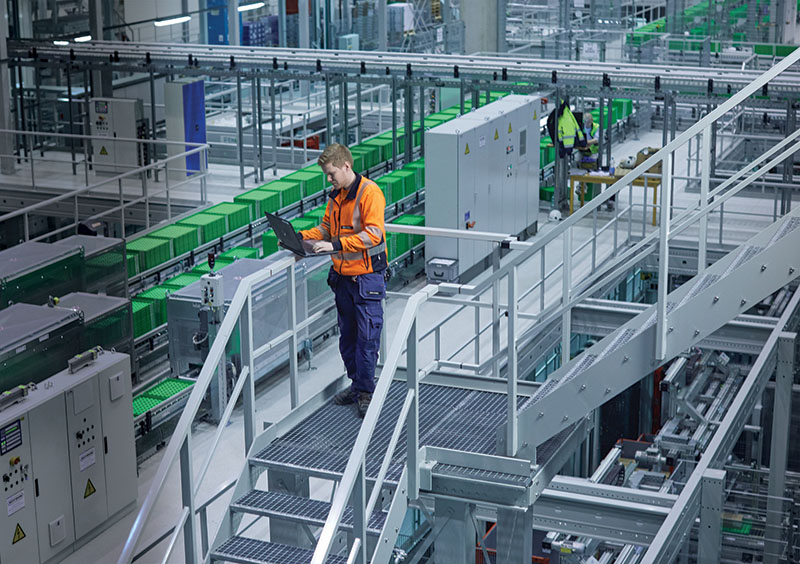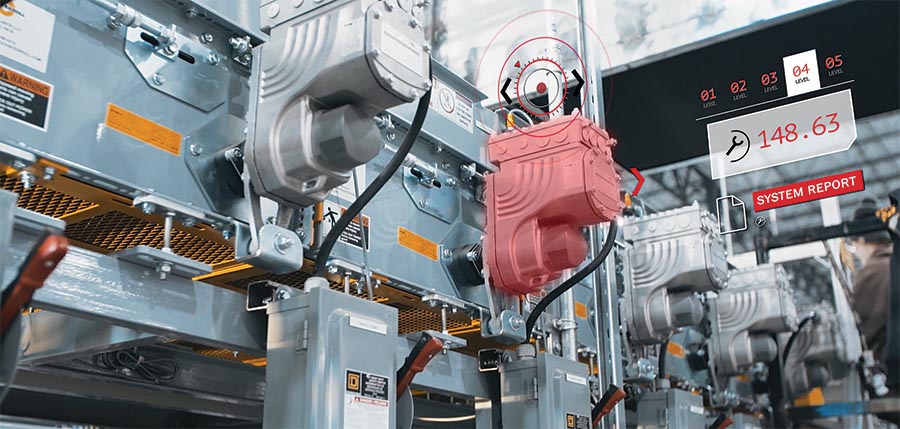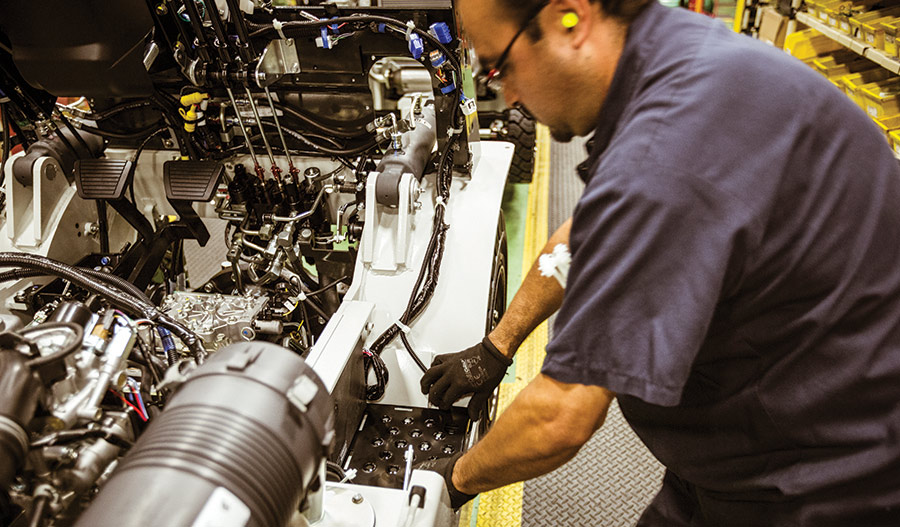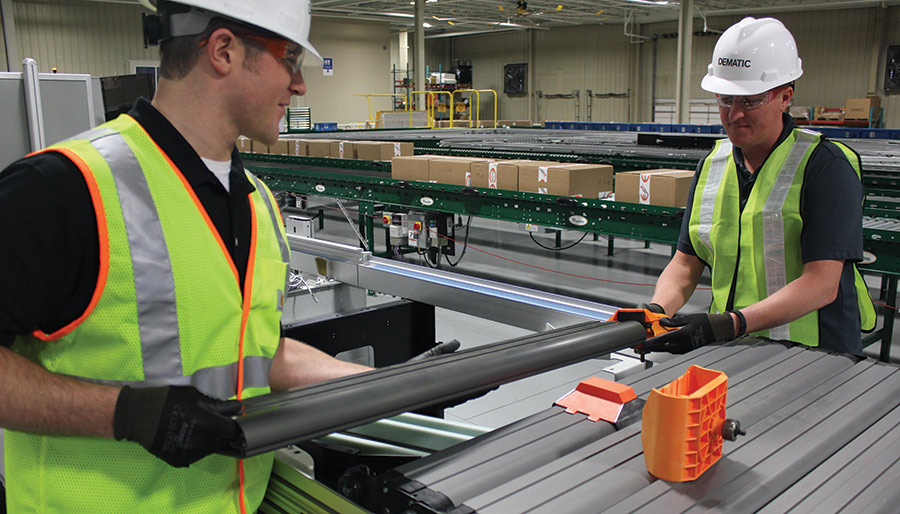The state of materials handling maintenance, repair and operations (MRO)
Materials handling MRO continues to evolve since we launched our coverage four years ago.

At MHI’s 2019 annual conference, Brian Poveromo, the senior facility manager for American Eagle’s 1.6-million-square-foot Pennsylvania distribution center, was asked whether he would ever outsource his maintenance operations to a third party. His answer was no. The reason was that he was not convinced that a technician working for a third party would experience the same sense of pain as his own crew if the system was down for 30 minutes. A little later in the same meeting, Meredith Westafer, a senior industrial engineer with Tesla Motors, was asked if she had a message for the materials handling industry: “Don’t forget us after the sale,” she said. “We need you to be there to help us improve our systems.”
Those two answers say a lot about the state of materials handling MRO some five years after we published our first article on the topic in the fall of 2014. A majority of end users still perform their own maintenance—for now. But they also want some level of support after the sale to ensure the system continues to perform as designed. And, there’s anecdotal evidence that as distribution systems rely more on software, sensors and PLCs, end users are taking a second look at resident maintenance programs.
Add to that the difficulty in finding and retaining qualified technicians, and outsourcing maintenance can look pretty attractive. Take, for instance, Coop, the company featured on the December cover of Modern Materials Handling. When the grocery and general merchandise cooperative replaced a conventional DC with one of the most automated facilities in Europe, Ove Bjorgum, Coop’s director of logistics, had a simple motto: “If the job requires a tool, that’s not a Coop employee.” Instead, he outsourced the monitoring and maintenance of his facility to Witron.
“When a company buys one of these big automated systems, they don’t want to be left alone to them running,” says Norman Leonhardt, director of business development for Witron.
In the following pages, we highlight interviews with four leading solution providers on what they see as the state of MRO, including the emergence of predictive maintenance, lift truck maintenance and resident maintenance programs.
Predictive maintenance: Are we there yet?
For years, companies have employed two approaches to maintenance: Run it until it breaks or implement a preventative maintenance program based on hours of operation.
The step beyond is predictive maintenance, where real-time operational data is monitored and analyzed to predict when a part or component, like a conveyor motor, might fail. There is a lot of buzz around predictive maintenance. And in industries where both reliability and safety are paramount, such as oil and gas refineries and nuclear power generation, predictive maintenance is a mature space, says Todd Cranford, senior director for product development at MHS. “But, in the materials handling space, they’re very new.” So, are we there yet? “Customers want to learn how to do predictive maintenance,” Cranford says, “but they don’t have the foundation in place for a predictive reliability program.”

The missing piece is digital transformation. Predictive maintenances relies on sensors to capture data and software systems to do the analysis. Those capabilities can be built into new equipment, but most facilities are brownfields that have been operating for five, 10 or 20 years. “Most companies don’t have the sensors in place to get the good clean data that’s necessary,” Cranford says. “That digital transformation piece is the hardest.”
The state of the art is condition monitoring, he says, which uses data from computerized maintenance management systems (CMMS) and sensors to understand the meantime before failure of equipment, and then create optimal schedules for preventative maintenance to mitigate downtime. “We can take an oil sample and recommend a change or look at variances in the vibration of a gearbox,” he says.
While predictive maintenance is in early stages now, Cranford expects that in the next two to five years, the materials handling industry will “be much more advanced and catching up to other industries in the space.”
The smart truck is coming, but adoption is slow
The lift truck industry may have been the first vertical in the materials handling space to begin talking about using sensors, or telematics, and connected trucks for predictive maintenance. And yet, some 10 years after those discussions began, in many respects, solutions are just now coming to fruition, says Kevin Fick, director of aftermarket sales for UCA (UniCarriers). And, the market has been slow to adopt.
Part of the barrier to adoption of the smart truck is the nature of many large fleets. “It’s one thing to have a customer order 50 trucks from us with telemetry installed at the factory,” says Fick. “It’s another to go into an account that has 50 of our trucks and 50 or more from other vendors. We know how to connect our trucks, but connecting the whole fleet is a barrier.”
A second is that the amount of data generated by smart trucks can be overwhelming: In many instances, lift truck operators who initially used the new capabilities ended up turning off the data because they didn’t know what to do with it.
Last, for an OEM to truly make meaningful maintenance recommendations, it has to collect a lot of data from a lot of trucks before it can understand how parts will perform over time. That’s something most OEMs have not done.
Instead, customers want to use the truck systems for access control, to ensure that operators are trained and certified for the trucks they’re going to operate, and to automate operator checklists to ensure that the truck is safe and ready for work. And, when it comes to the aftermarket, lift truck companies and their dealers are refining existing maintenance services, like one-call service that allows a large fleet operator with multiple locations to call UCA, which will dispatch a technician from the dealer nearest the repair and provide consolidated billing. Or, to provide vendor-managed parts inventory programs on site and at a dealer’s warehouse.
Still, the smart truck is coming. “We’re on the edge of a lot of change that hasn’t happened yet,” says Fick. “But in the coming years, I believe you’ll see some of these things come to fruition.”
It’s technical
Go to any supply chain or materials handling conference, and the No. 1 topic is usually the labor shortage. Materials handling automation technicians are no exception, says Todd Sermershein, Dematic’s vice president, customer service operations. “When I go to meetings with our customers, they are finding the same challenge I experience with getting technicians.” In fact, one of Sermershein’s customers is delaying the startup of a new facility because it can’t hire enough technicians to keep the system up and running. And in a world where next-day and same-day service is becoming the norm, uptime is paramount.

While OEMs have been talking about the smart lift truck for some time, it is finally coming to fruition.
Like smart trucks and predictive maintenance, resident maintenance programs are still the exception than the norm. “I’d estimate that 70% of the market that isn’t doing a resident maintenance program now,” Sermershein says, but interest is grown. A major contributing factor is the difficulty in finding technicians. “If they put the burden of finding, training and keeping technicians on someone else, they can focus on what they do best,” Sermershein says.
“Our customer’s HR departments don’t have the background for that kind of job requirement, and they may have to start from scratch to find community colleges or organizations in their area to train people,” adds Leonhardt from Witron. “Companies like Witron, and our competitors, understand the skills that are required, and we have the expertise in house to do the hiring.”

Technicians are in high demand and low supply. The best companies are using internships for training and benefits for retention.
Another factor is that some resident maintenance contracts now include key performance indicators (KPIs) that tie the uptime and performance to the maintenance provider’s revenue. That can be attractive to maintenance managers who are concerned that the service provider won’t feel their pain. “If we don’t hit our KPIs, we can’t invoice the full amount of the contract,” Sermersheim notes. “That can be attractive to some customers because we now have skin in the game.”
System integrators like Dematic and Witron are competing for the same pool of technicians as their customers, but for them, creating maintenance teams is a best practice. “It’s not a trade secret that we and our competitors are working with trade schools and community colleges with programs designed to teach maintenance and tech skills,” Sermersheim says. Increasingly, the military is a source of technicians. “Ex-military folks are typically a great fit because they’re often educated in maintenance, they know how to follow the rules, and they’ve typically moved around as part of their careers,” he adds.
In a similar vein, Dematic and Witron both operate intern and apprentice programs. Witron, for instance, offers a two-year apprenticeship in Germany. While most of the 300 apprentices currently in the program are from Western Europe, Leonhardt notes that 5% to 10% come from other regions, including the United States.
Beyond that, these companies are taking other steps to attract and keep younger technicians into the field as experienced technicians in their 50’s and 60’s retire. Salaries and benefits are improving. And, continuing education is important. “Having a strong training program, including ongoing training, is critical,” Sermersheim says. “The younger technicians entering the field want to know more, especially around data and IoT; they want to learn more; and they want to become more valuable to the organization.”
Systems integrators also argue that the hands-on experience they get working with their systems, and the data they can collect and analyze, benefits customers in the long run. “If we can work with a system over a five- or 10-year contract, we learn a lot that can help us improve our solutions,” says Leonhardt. “There’s a real advantage to having a relationship with the customer at a high
level of service.”
Companies mentioned in this article:

Article Topics
MRO News & Resources
Avidbots showcases autonomous cleaning robots Traka exhibits modular lockers MRO Survey: Finding and keeping the best technicians Maintenance, Repair and Operations: Understanding the true condition of the equipment Newly formed Bison combines AMETEK DFS and Bison Gear and Engineering Corp. Building (and maintaining) your maintenance, repair and operations (MRO) tech workforce The power side of lift truck battery and charger maintenance More MROLatest in Materials Handling
Registration open for Pack Expo International 2024 Walmart chooses Swisslog AS/RS and software for third milk processing facility NetLogistik partners with Vuzix subsidiary Moviynt to offer mobility solutions for warehouses Materials Handling Robotics: The new world of heterogeneous robotic integration BSLBATT is looking for new distributors and resellers worldwide Lucas Watson appointed CSO for Körber’s Parcel Logistics business in North America Hyster recognizes Dealers of Distinction for 2023 More Materials HandlingAbout the Author
Subscribe to Materials Handling Magazine

Find out what the world's most innovative companies are doing to improve productivity in their plants and distribution centers.
Start your FREE subscription today.
April 2024 Modern Materials Handling

Latest Resources










